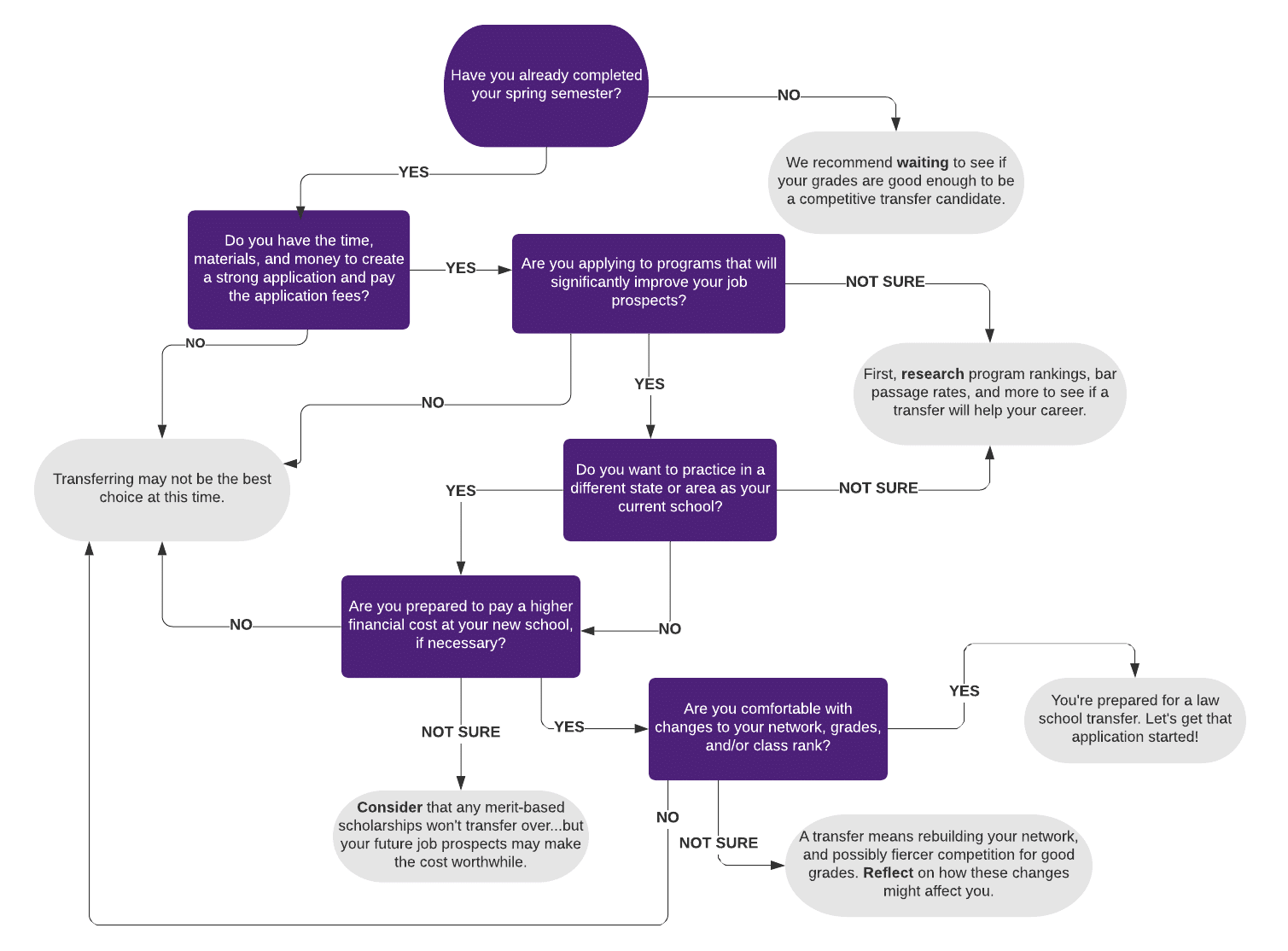
Once those long-awaited first semester 1L grades are released, you might start hearing chatter from students who are considering a transfer to another law school. Some students go into the first year of law school with a plan to transfer. But more often, students will consider a school transfer for personal reasons, such as being closer to family, or for professional reasons, such as better job prospects from another school.
If you have a great 1L GPA and a high class rank (top 10%), a law school transfer could be a possibility for you. However, a law school transfer is a big decision that should not be taken lightly, so we created Law School Transfer Predictor to help make your decision easier.
Table of Contents
- Law School Transfer Predictor: Find out if it’s a good idea to transfer for you!
- How to Transfer to Another Law School
- More Tips for Law School Transfer Applicants
Law School Transfer Predictor: Is it a good idea to transfer law schools?
There’s a lot to consider before taking the leap to transfer law schools. Ideally, we recommend waiting until your spring semester before seriously considering a transfer. Even if you came into law school planning a transfer, waiting until the spring semester will help you realize why you want to transfer and what needs to change from your 1L experience.
By the spring, you’ll know if you’d be a competitive transfer candidate based on your 1L grades. That said, if your mind is made up to transfer when you start your 1L year, focus your time on becoming the most competitive candidate that you can be. Achieve high grades, join extracurricular activities, and create relationships with professors who could write you a letter of reference.
Click here for a larger version of the flowchart.
Reasons Why You May Not Want to Transfer
Building a new network and new relationships from scratch.
Your 1L classmates are not only your friends, but your future colleagues. Transferring to another law school will mean leaving your 1L friends behind and entering a new class of students who have already had a year to get to know each other. Additionally, you will have to start from scratch to build new relationships with professors and school admin.
If you’re considering a transfer, you likely had excellent grades and professors who know and admire you. Professors are a wealth of professional advice, and they love to make introductions with other attorneys on your behalf. As a final note here, you should plan to work in the same general area that the school is in, for at least the first couple years of your career. So, if you realize during your 1L year that there is no way you’d want to stay in that region for a while after graduation, transferring could be a smart move.
Your grades and class rank could suffer.
If you’re transferring to a more competitive and higher ranked school, you’ll be joining a group of students who entered law school with a higher average GPA and LSAT score. The competition for good grades in law school will become more fierce, so you might not remain at the top of your class.
Before deciding to transfer, consider how this could affect not only your career prospects, but also your own mental health and feelings of confidence. In addition, your 1L GPA will not transfer, so you’ll be starting over to build up your 2L and 3L GPA. A more competitive group of students will also make it more difficult to obtain that coveted internship or scholarship.
Time and cost to apply.
Remember the time you spent last year researching programs, writing a personal statement, filling out applications, and gathering letters of recommendation? You’ll have to go through all these steps again in addition to paying the application fees for each school.
Missing out on opportunities such as Journal or On Campus Interviews (OCI).
The write-on competition to join a Journal in law school typically takes place the summer between your 1L and 2L year. If you apply to transfer and you’re accepted in July or August, you have likely missed the deadline to write-on.
While some schools do not let transfer students join the journal, others might let them do the write-on late, so be sure to check with your transfer school if you’re interested in a joining a Journal. Similarly, check with your school about their summer OCI program, and figure out if you will have the chance to place your bids for OCI employers.
High financial cost.
If your 1L school offered you a merit based scholarship, it will not transfer to your new school. The majority of law schools do not offer merit based scholarships to transfer students, so they will expect you to pay the full sticker price of the program. Compare your current school’s ranking, bar passage rate, and employment history to the schools that you are considering.
Moving up a few spots in the rankings to another school with similar bar passage rates will not dramatically change the trajectory of your professional career, so it might not be worth the large increase in cost. However, if you believe that that the job prospects will be significantly better with this new program, the high cost could be worth it for you.
How to Transfer to Another Law School
Applying for a transfer is not unlike applying for your first year of law school, except that you already have your LSAT score. Transfer application requirements can differ between programs, but generally you will need to send a resume, personal statement, 1-2 letters of recommendation, your LSAT score, application fees, and your first year transcript.
Timing
It’s best to time your application so that you are applying during the spring of your 1L year. You won’t have your spring grades yet, but you can send those separately once you receive them. Some schools such as Georgetown and Vanderbilt offer early admission to transfer students, so you could get an offer based solely on your first semester 1L grades. Most schools, however, will want a copy of your complete 1L transcript.
Personal Statement
Importantly, do NOT use the same personal statement that you used to apply to programs last year. The personal statement for your transfer application should incorporate the experiences you’ve had throughout your 1L year and explain how those experiences have led you to apply for this new program.
What are the factors that caused you to apply to the program you’re in now, but are no longer right for you? How does this new school equip you to achieve your goals in the way that your current program does not?
Research the school’s curriculum, clinics, and professors, and pull out specific reasons that this transfer school is the right fit for you. Even if there are personal reasons for your desire to transfer – such as your spouse’s new job in another state – focus the bulk of your essay on the attributes of the program.
Lastly, be sure to highlight how your experiences and skills would contribute to the program.
Which law schools accept the most transfers?
Law school transfer data is published every year in a report from the ABA website, so I encourage you to download the reports from previous years to figure out how many transfer students your desired program has admitted over the years. The report also contains GPA percentiles so you can determine how competitive of an applicant you will be based on your 1L grades.
You’ll probably notice that the transfer student numbers vary widely from year to year. If a law school sees a significant portion of their 1L class withdraw or drop out, they will likely accept a higher number of transfer students in order to make up for the lost revenue. On the other hand, if the law school admitted a higher than average class and the students remained enrolled, they may not have room for additional transfer students.
In 2020, three schools topped the list with their high number of transfer students because they admitted between 95-110 students:
- Georgetown University
- University of Idaho
- George Washington University.
In the next tier, three schools admitted between 50-65 students:
- University of Florida
- NYU
- Harvard
A higher number of schools admitted between 30-50 transfer students:
- Columbia
- UC Berkeley
- UCLA
- Florida State
- Northwestern
- University of Miami
- Loyola Marymount
What do law schools look for in transfer students?
The most important parts of your application BY FAR are your class ranking and your 1L grades. Schools see these numbers as an indicator that you can be successful in law school and you are willing to put in the hard work to be top of your class.
Of course, the lower the ranking of your school, the higher your GPA and class rank will need to be. Most schools only admit transfer students in the top 5-10% of their class, so take this seriously.
If your GPA and class rank are high enough for the program, they will also consider your law school extracurriculars. They’ll look at whether you participated in clubs, student organizations, and pro bono or volunteer opportunities. Law schools want to see transfer students that were involved in their school community and contributed in positive ways.
More Tips for Law School Transfer Applicants
What happens after I submit my law school transfer application?
If you are accepted as a transfer student to another school, congratulations!! You should be proud of all the hard work it took to get you there. Be sure to tell your current school that you will be transferring, and then reach out to your new school to discuss which credits will move over and which classes you will need to take during your 2L year to make sure you graduate on time.
In addition, I’d recommend reaching out to career services at your new school to introduce yourself and discuss their OCI program. You should also contact financial aid to ensure that your tuition is in order. Be sure to ask them about any scholarships that are available to transfer students. Finally, let your landlord know that you’ll be moving and start the process of finding a place to live in your new city.
What can I do during my 1L year to prepare for a transfer?
Focus on getting great grades.
I mentioned this above, but if you’re serious about transferring, it bears repeating. Transfer schools often will not even consider your application if you’re not in the top 5-10% of your class 1L year. Law schools want students who have proved that they can be successful, so this is where you ‘ll make the most impact.
Spend time prepping for exams early, attend office hours, and check to see what academic resources are available to you such as 2L and 3L tutors or mentors. Many professors are also willing to share exams that they have given in previous years so you’ll be able to take them as a practice exams. I also recommend asking 2Ls and 3Ls for outlines – which are essentially consolidated notes that students use for studying and they’re often passed down from class to class.
Get to know your professors.
You will need 1-2 letters of recommendation for your transfer application and least one of them should come from a 1L professor who can speak to your academic success and dedication. Going to your professor’s office hours is a great way to create a relationship with them. Also be sure to keep up with the reading and ask good questions during class.
Become involved in extracurricular activities.
Join clubs, run for the Student Bar Association, participate in competitions such as mock trial (if they’re available your 1L year), and take volunteer opportunities that are available to you.
Not only is this a great way to show that you can contribute to the legal community at your new campus, but these activities can serve as basis for your statement of interest as you start to solidify what your professional aspirations are. Professors and faculty members are also often involved in clubs, so this is a perfect way to get to know them for your letters of recommendation.
Don’t limit yourself.
When applying to programs, cast a wide net. As you’ll see in the ABA report, the number of transfer students that a school will admit can vary wildly from year to year due to factors out of your control. The more schools you apply to, the better your chances will be.
There are many factors to think about if you’re considering a transfer to another law school, but we hope that this blog post helps you to decide if it’s the right path for you! Good luck 🙂






Leave a Reply